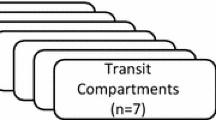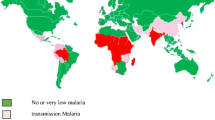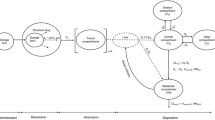Abstract
Background
Artesunate is a commonly used antimalarial drug derived from artemisinin. It is rapidly converted to dihydroartemisinin. Little is known on this conversion in the GI tract and blood, and how this influences absorption. In order to study the absorption phase of the kinetics of artesunate following oral administration in rats, samples were collected at baseline, and then 0.5, 2, 5, 10, 15, 30, 45, 60 and 120 minutes after a single dose of 150 mg.
Results
Peak concentration of parent artesunate and dihydroartemisinin was achieved within 5 and 37.5 +/- 8.7 min, respectively of start of administration through gavage. The half lives of absorption were 2.73 +/- 0.85 and 12.49 +/- 2.49 min, respectively.
Conclusions
These times were considerably shorter for artesunate than those found in studies which start sampling later. The profiles of parent compound and metabolite result from a complex equation dictated by the pH-dependent rates of hydroxylation of artesunate to dihydroartemisinin, the different rates at which either compounds are absorbed, and the catalytic hydroxylation by esterases. The rate of chemical oxidation of artesunate is pH dependent; this explains its rapid conversion to dihydroartemisinin in the stomach, as compared to its greater stability in other compartments at higher pH and in plasma. We propose that variable proportions of absorption take place in the stomach, and conclude that parent artesunate reaches an early peak within minutes of dosing, and that the early dihydroartemisinin levels result primarily from the absorption of the metabolite as such.
Similar content being viewed by others
Background
Artesunate, dihydroarteminsinin -10α – hemisuccinate, is a semi-synthetic derivative of artemisinin which is used for the treatment of both uncomplicated and severe malaria. It is formulated for oral, parenteral (intramuscular and intravenous) and rectal administration and used clinically worldwide. Because of rapid hydrolysis to dihydroartemisinin (also referred to as artenimol), artesunate is considered by many as a prodrug of the latter (for review see Navaratnam et al [1]).
Current knowledge of the absorption phase after oral administration is incomplete. We have established that artesunate stability varies as a function of pH and temperature. This transformation of artesunate to dihydroartemisinin follows pseudo-first order kinetics at constant temperature; as a result, in the stomach at pH 1.2 artesunate is short-lived (tl/2 = 10.3 minutes), whilst at neutral pH its half life is significantly longer (tl/2 = 7.3 hours in plasma) (unpublished data; manuscript in preparation). Esterases too play a role in the oxidation of artesunate [2]. It is therefore not surprising that pharmacokinetic studies that start sampling too late after dosing may fail to detect artesunate.
Therefore, we conducted a study with intense, early sampling focusing on the absorption phase after oral intake. This investigation describes the pharmacokinetics of artesunate and its metabolite dihydroartemisinin in rats following a single oral administration of 150 mg/kg of artesunate.
Results and Discussion
The mean AUC0-t and Tmax values of artesunate were 18,968 ± 8,012.4 ng min/ml and 5.0 ± 0.0 min respectively. The corresponding values for dihydroartemisinin were 74,500 ± 16,806.1 ng min/ml and 37.5 ± 8.7 min respectively. The mean calculated absorption tl/2 was 2.73 +/- 0.85 min for artesunate and 12.49 +/- 2.49 min for dihydroartemisinin (see Table and Figure). The elimination tl/2 could not be calculated due to insufficient data points, because the study was designed to study the absorption phase.
In another study in the rat [3] in which oral, intramuscular and intravenous administration of artesunate in 0.9% saline were compared, the Tmax after oral administration of artesunate at 10 mg/kg was 30 minutes. Bioavailability after oral administration was 29.5 ± 4.6%.
The Tmax of artesunate following oral administration in published studies in humans varies between an average of 0.25 hr (15 min) [4, 5] and 0.66 hr (39.6 min)[6] in healthy volunteers, and 1.7 hr (ca. 1 hr 42 min) in children with falciparum hyperparasitaemia [7]. The calculated absorption tl/2 of parent compound for two different formulations of oral artesunate were 0.18+/- 0.16 and 0.16+/-0.16 hr in one study (10.8 and 9.6 min respectively) in healthy volunteers [8]. In another study, the Tmax was longer in convalescent than acute phase patients (0.5 and 1 hr (30–60 min), following the administration of 200 and 100 mg of artesunate, respectively) [9]. First sampling point was reportedly 0.25 hr (15 min) in two studies [6, 7] and 1 hr in one [8]. Overall, published animal and healthy volunteers data are in general agreement, and correspond to the Tmax of dihydroartemisinin in this study. Parameters are modified during malaria infection.
This study shows that parent artesunate reaches its peak more rapidly than what could be anticipated based on earlier studies that start sampling later. The profiles of parent compound and metabolite result from a complex equation dictated by the pH-dependent rates of hydroxylation of artesunate to dihydroartemisinin, the different rates at which either compounds are absorbed, and the catalytic hydroxylation by esterases. Because of the rapid conversion of artesunate to dihydroartemisinin in the stomach, as compared to artesunate's greater stability in plasma, we conclude that the early dihydroartemisinin levels result primarily from the absorption of the metabolite as such. To our knowledge, there is sufficient data to conclude whether artesunate and/or dihydroartemisinin are absorbed, and to what extent, in the stomach with respect to absorption in the small bowel. This study, plus the in vitro data, indicate that the rate of hydroxilation in the stomach (artesunate tl/2 at pH 1.2 = ca. 10 min) is faster than the transit time in either empty or full stomach. So, the proportional absorption of the two moieties in either the stomach or the small bowel will likely depend on a variety of factors affecting transit, acidity and bioavailability of the formulation used. These equilibria will be developed in a separate paper.
Sampling times in pharmacokinetic studies in both animals and humans may need to be adjusted accordingly in order to adequately describe the absorption phase. Ultimately, for antimalarial effect what matters is the combined bioactivity of parent and metabolites. Our results do not affect this parameter. Rather, they are of practical relevance to both a better understanding of artesunate's ADMET (particularly the absorption component thereof) and the assessment and design of suitable formulations.
Materials and Methods
The drug was administered to five batches of ten male Spraque-Dawley rats housed in a ventilated room at ambient temperature (25°C). The rats were starved overnight before dosing. The animals used weighed between 200 g and 250 g. Artesunate was prepared as a suspension (vehicle: 10% Poly-ethylene Glycol 200) and administrated orally using an appropriate oral dosing needle. The formulations were prepared on the day of dose administration by suspending a weighed quantity of drug in the appropriate quantity of vehicle and the suspension was sonicated for 30 seconds. The formulation was administered within 5 minutes of preparation by oral gavage.
Bloods samples (1.5 ml) were drawn by cardiac puncture. Samples were collected at pre-dose (time 0), and then 0.5, 2, 5, 10, 15, 30, 45, 60 and 120 minutes after administration. Blood samples were obtained from one rat at each sampling time point. Animals were anaesthetized using diethyl ether during the procedure (those animals that were bled at 0.5 and 2 minutes were anaesthetized prior to dose administration). The protocol was approved by the Institution's animal ethics committee.
Plasma samples were extracted into ethanol-water and analysed using an HPLC-ECD (electro-chemical detector) in a mobile phase of acetonitryl and 0.5 M HCl adjusted to pH 5.0 as described previously [5].
The calibration curve range was 10 ng/0.5 ml to 800 ng/0.5 ml; detector linearity for artesunate and dihydroartemisinin gave an r>0.999; recovery of artesunate was 75.5 ± 4.9% with CV of 6.5%; recovery of dihydroartemisinin was 93.1 ± 1.8% with CV of 1.9%.
Peak plasma concentration (Cmax) and time to reach peak concentration (Tmax) for artesunate and dihydroartemisinin are reported as the observed values. The area under the plasma concentration versus time curve (AUC) from time 0 to time t of artesunate and dihydroartemisinin were calculated by linear trapezoidal summation using model independent Topfit programme. The absorption half-live (tl/2) was calculated using model independent Topfit programme. The matrix used for the standard curve was plasma, ethanol/water (50:50,v/v) and deionized water; 0.5 ml plasma and Artemisinin (Internal Standard, 5 μl, 40 ng/μl) were spiked into a silanized test-tube. Appropriate amount of artesunate and dihydroartemisinin were spiked into the tubes separately and were diluted to 1 ml with water.
References
Navaratnam V, Mansor SM, Sit N-W, Grace J, Li Q, Olliaro P: Pharmacokinetics of artemisinin-type compounds. Clin Pharmacokinet. 2000, 39 (4): 256-270.
Zhou ZM, Anders JC, Chung H: Analysis of artesunic acid and dihydroqinghaosu in blood by high-performance liquid chromatography with reductive electrochemical detection. J. Chromatogr. 1987, 414 (1): 77-90.
Li Q-G, Peggins JO, Fleckenstein LL, Masonic K, Heiffer MH, Brewer TG: The pharmacokinetics and bioavailability of dihydroartemisinin arteether, artemether, artesunic and arteline acid in rats. J Pharm Pharmacol. 1998, 50: 173-82.
Na-Bangchang K, Congpuong K, Hung LN, Molunto P, Karbwang J: Simple high-performance liquid chromatographic method with electrochemical detection for the simultaneous determination of artesunate and dihydroartemisinin in biological fluids. J Chromatogr B Biomed Sci Appl. 1998, 708 (1–2): 201-207. 10.1016/S0378-4347(97)00667-1.
Benakis A, Paris M, Loutan L, Plessas CT, Plessas ST: Pharmacokinetics of artemisinin and artesunate after oral administration in healthy volunteers. Am J Trop Med Hyg. 1997, 56: 17-23.
Navaratnam V, Mordi MN, Mansor SM: Simultaneous determination of artesunic acid and dihydroartemisinin in blood plasma by high-performance liquid chromatography for application in clinical pharmacological studies. J. Chromatogr B Biomed Sci Appl. 1997, 692 (1): 157-62. 10.1016/S0378-4347(96)00505-1.
Bethell DB, Teja-Isavadharm P, Cao XT, Pham TT, Ta TT, Tran TN, Nguyen TT, Pham TP, Kyle D, Day NP, White NJ: Pharmacokinetics of oral artesunate in children with moderately severe plasmodium falciparum malaria. Trans R Soc Trop Med. 1997, 91: 195-198.
Na-Bangchang K, Karbwang J, Congpoung K, Thanavibul A, Ubalee R: Pharmacokinetic and bioequivalence evaluation of two generic formulations of oral artesunate. Eur J Clin Pharmacol. 1998, 53 (5): 375-376. 10.1007/s002280050397.
Karbwang J, Na-Bangchang K, Congpoung K, Thanavibul A, Harinasuta T: Pharmacokinetics of oral artesunate in Thai patients with uncomplicated falciparum malaria. Clin Drug Invest. 1998, 15 (1): 37-43.
Acknowledgments
This study was carried out under the memorandum of understanding between the Government of Malaysia/ MoH and WHO/TDR.
Author information
Authors and Affiliations
Corresponding author
Authors’ original submitted files for images
Below are the links to the authors’ original submitted files for images.
Rights and permissions
This article is published under an open access license. Please check the 'Copyright Information' section either on this page or in the PDF for details of this license and what re-use is permitted. If your intended use exceeds what is permitted by the license or if you are unable to locate the licence and re-use information, please contact the Rights and Permissions team.
About this article
Cite this article
Olliaro, P.L., Nair, N.K., Sathasivam, K. et al. Pharmacokinetics of artesunate after single oral administration to rats. BMC Pharmacol 1, 12 (2001). https://doi.org/10.1186/1471-2210-1-12
Received:
Accepted:
Published:
DOI: https://doi.org/10.1186/1471-2210-1-12





